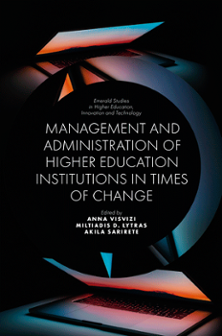
Index
Management and Administration of Higher Education Institutions at Times of Change
ISBN: 978-1-78973-628-1, eISBN: 978-1-78973-627-4
Publication date: 4 October 2019
Citation
(2019), "Index", Visvizi, A., Lytras, M.D. and Sarirete, A. (Ed.) Management and Administration of Higher Education Institutions at Times of Change (Emerald Studies in Higher Education, Innovation and Technology), Emerald Publishing Limited, Leeds, pp. 193-198. https://doi.org/10.1108/978-1-78973-627-420191014
Publisher
:Emerald Publishing Limited
Copyright © 2019. Editorial matter and selection the Editors, published under exclusive licence. Individual chapters the respective authors.
INDEX
Note: Page numbers followed by “n” with numbers indicate foot notes.
- Prelims
- Chapter 1: Emerging Technologies and Higher Education: Management and Administration in Focus
- Chapter 2: How Can Higher Education Institutions (HEIs) Engender Enterprising Behavior from within Under-represented Communities?
- Chapter 3: From Content- To Competence-oriented Design of HE Curricula: Leadership in Times of Transition
- Chapter 4: University Social Responsibility from the Industrial Value Creation Program Perspective
- Chapter 5: Four Obstacles to Improving the Quality of University Education: The Case of Hungary
- Chapter 6: A Happy Dean’s Office: But Is There One? The Case of Polish HEIs
- Chapter 7: Thriving in Higher Education: Creating the New Normal Through Resilience
- Chapter 8: Innovation in the Quality Life Cycle of Higher Education Institutions: The Case of Effat University
- Chapter 9: Entrepreneurial University and Organizational Innovation: The Case of Arabian Gulf University, Bahrain
- Chapter 10: Challenges and Opportunities in the Digital Transformation of the Higher Education Institutions: The Case of Mexico
- Chapter 11: Transitioning to Digital Games-based Learning: The Case of Scottish Universities
- Chapter 12: Managing Student Engagement in Higher Education Institutions: The Case of Curpa
- Chapter 13: By Means of Conclusion: ICT at the Service of Higher Education in a Transforming World
- Index